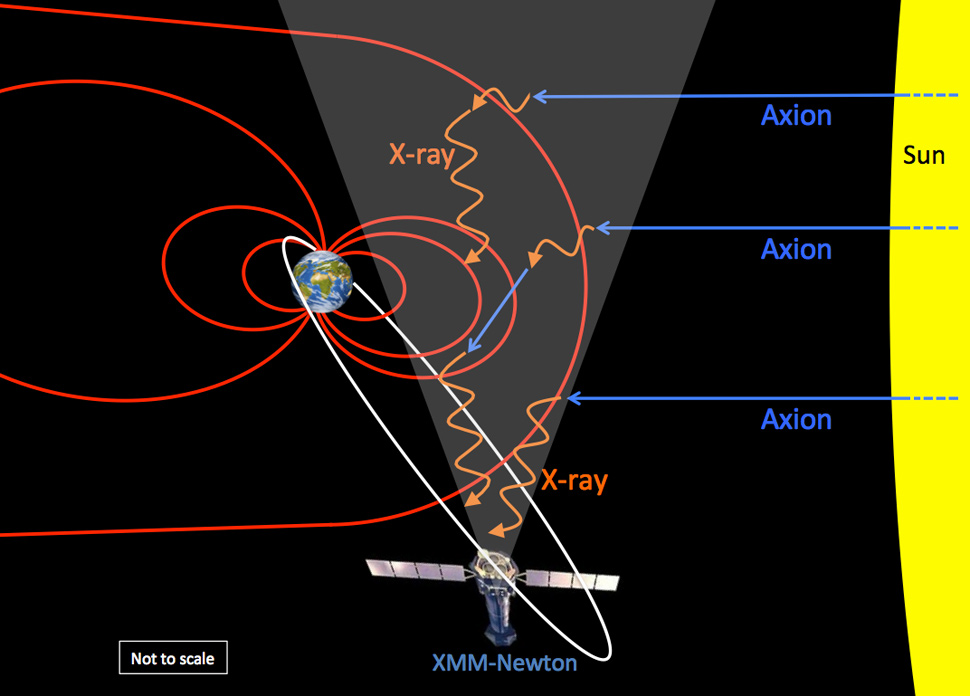Axions are an intriguing component of modern physics, representing a key candidate in the ongoing quest to understand dark matter, the elusive substance believed to make up a significant portion of the universe’s mass. These hypothetical particles, if confirmed, could fundamentally reshape our understanding of particle physics and help unravel the mysteries surrounding the cosmos. Researchers are now exploring the use of quasiparticles in experiments aimed at detecting axions, leveraging advanced quantum technologies to bridge theoretical concepts with tangible outcomes. For instance, recent studies involving manganese bismuth telluride have offered insights into the dynamics of these axion quasiparticles, paving the way for potential breakthroughs in dark matter detection. As scientists delve deeper into this frontier of quantum mechanics, the implications of confirming the existence of axions could resonate throughout various fields, from condensed matter physics to cosmology.
In the vast realm of cosmic exploration, the search for axion particles has emerged as a pivotal endeavor within the field of particle physics. These theoretical entities serve as a potential resolution to the enigma of dark matter, a perplexing component that is believed to constitute a staggering 85 percent of the universe’s mass. By investigating alternative forms of matter interaction, including quasiparticles, researchers are employing innovative methodologies to unveil the characteristics of axions. Studies utilizing distinctive materials like manganese bismuth telluride represent a concerted effort to harness quantum technologies for uncovering dark matter’s secrets. This multidimensional approach not only enhances our comprehension of the universe but also sets the stage for future advancements in both theoretical and practical applications.
The Search for Axions: Understanding Dark Matter
Dark matter remains one of the most elusive phenomena in astrophysics, making up approximately 85% of the universe’s mass yet remaining undetectable by traditional methods. Researchers have long theorized the existence of axions, particles that, if confirmed, could provide significant insights into the nature of dark matter. These hypothetical particles are proposed to solve complex issues in particle physics, particularly in understanding how mass and energy interact in the cosmos. The recent breakthrough involving quasiparticles offers a fresh avenue for examining these particles, potentially confirming their role as constituents of dark matter.
As scientists delve deeper into this mysterious realm, the adoption of advanced techniques such as ultrafast laser optics has proven crucial. These methods not only help visualize axion quasiparticles but also pave the way for novel experiments that could eventually lead to their discovery. The implications of discovering axions extend beyond theoretical physics; they could revolutionize our understanding of the universe, redefining our comprehension of gravity, mass, and the fundamental forces operating at cosmic scales.
Quasiparticles as Probes in Particle Physics
Quasiparticles, which emerge from particle interactions in condensed matter physics, are increasingly becoming the focus of research in the quest for understanding dark matter. In the context of axions, quasiparticles serve as simulators that can mimic the properties of axion particles themselves. By detecting the excitation of these quasiparticles in materials like manganese bismuth telluride, researchers can gather essential data that may corroborate the existence of actual axions.
The utilization of advanced materials and nano-fabrication techniques allows scientists to create environments where quasiparticles can exhibit coherent behaviors indicative of their theoretical counterparts. This nexus between material science and particle physics not only enhances our capability to detect dark matter candidates but also lays groundwork for technological advancements in fields such as quantum computing and advanced materials.
Manganese Bismuth Telluride: A Breakthrough Material
Manganese bismuth telluride is a remarkable material in the study of axions and dark matter. Its unique electronic and magnetic properties make it an ideal platform for nurturing axion quasiparticles. Researchers have devoted years to understanding and manipulating this compound, meticulously crafting its structure to ensure the optimal conditions for facilitating experimental observations. The development of a 2D crystal structure using this material has led to a new frontier in probing the elusive nature of dark matter.
The air-sensitive nature of manganese bismuth telluride poses challenges, yet it also drives innovation in nano-fabrication and material engineering. By exfoliating this compound to a few atomic layers, scientists can tune its properties precisely, opening pathways to exciting experiments that may reveal the characteristics of axion quasiparticles. The interdisciplinary collaboration among researchers from various fields highlights the material’s potential as a centerpiece in future studies of dark matter.
The Role of Quantum Technologies in Dark Matter Research
Quantum technologies are revolutionizing the way scientists approach the investigation of dark matter, with axions at the forefront of this exploration. The integration of quantum materials such as manganese bismuth telluride into experimental frameworks allows for unprecedented levels of sensitivity in detecting phenomena associated with axion particles. This approach utilizes quantum principles to manipulate and measure the behavior of quasiparticles, enhancing the prospects of uncovering dark matter signals.
As quantum technologies evolve, so too does the promise of addressing some of the most fundamental questions in physics. The ability to tune into specific frequencies emitted by axion particles could lead to the development of extremely precise dark matter detectors. These advancements not only aim to verify the existence of axions but also seek to understand their implications on broader cosmic scales, potentially leading to a paradigm shift in particle physics.
Future Directions: Probing the Properties of Axion Quasiparticles
The ongoing research into axion quasiparticles is poised to yield significant advancements in our understanding of dark matter. As researchers refine their experimental methods and conditions, the potential to probe the unique properties of these quasiparticles becomes increasingly plausible. Future studies will focus on enhancing detection techniques and developing more sensitive measurement tools that could uncover new aspects of axion dynamics.
Equipped with the knowledge gained from current experiments, scientists are optimistic about creating a robust framework for probing axion dark matter. The integration of condensed matter physics and high-energy physics showcases the potential of multidisciplinary strategies in driving forward the field of particle physics. This convergence may not only confirm the existence of axions but could also lead to the discovery of other fundamental particles, challenging and expanding our current understanding of the universe.
The Interdisciplinary Nature of Axion Research
The search for axions is not confined to a single discipline; it draws upon a vast array of scientific fields, including condensed matter physics, quantum technologies, and material chemistry. The collaboration among researchers from diverse backgrounds has proven essential in advancing the methodologies and technologies used in this groundbreaking work. This interdisciplinary approach reflects the growing recognition that complex scientific questions often require expertise beyond traditional boundaries.
By embracing an interdisciplinary framework, researchers can leverage different techniques and perspectives, enhancing the robustness of their findings. As the field progresses, this collaborative spirit is expected to yield not only insights into dark matter but also innovations in technology that extend beyond particle physics, potentially impacting areas such as quantum computing, materials science, and even cosmology.
Quantum Materials: Key to Unlocking Dark Matter
Quantum materials are central to the ongoing quest to understand dark matter, particularly in the context of axion research. These materials possess extraordinary properties that allow researchers to manipulate quantum states, making them ideal candidates for probing the elusive axion particles. The unique characteristics of these materials facilitate the investigation of quantum phenomena, which could provide deeper insights into energy, mass, and particle interactions.
As quantum technologies continue to evolve, the synergy between advanced materials and theoretical predictions regarding axions will likely lead to groundbreaking discoveries. The field stands at the cusp of new technological innovations that could redefine our understanding of dark matter, unlocking pathways to detecting particles that have remained hidden from observation for decades. The future of particle physics is likely to be shaped significantly by the integration of quantum materials in experimental designs.
Confirmed Axion Existence: A Paradigm Shift in Physics
The confirmation of axions as fundamental particles would represent a monumental shift in theoretical physics, addressing longstanding questions regarding dark matter and the composition of the universe. This breakthrough would not only validate decades of theoretical work but also catalyze new research trajectories aimed at exploring the fundamental nature of materials and their interactions. A confirmed detection of axions could unify various theories within particle physics, proporcionando a comprehensive framework to understand mass, energy, and gravitation.
Moreover, the implications extend into various fields, including cosmology, where a deeper comprehension of dark matter could illuminate our understanding of the universe’s evolution. The path to confirming axions will likely drive a new wave of technological advancements, as scientists adapt and refine their experimental techniques. This potential for innovation underscores the interconnectedness of scientific discovery, where advancements in one area can significantly enhance knowledge in another.
The Future of Dark Matter Research: Looking Ahead
As the future of dark matter research unfolds, the pursuit of axions remains a focal point. The collective efforts of researchers from institutions worldwide highlight the urgency and excitement surrounding this topic. With the integration of novel materials, quantum techniques, and interdisciplinary collaboration, the landscape of particle physics is changing rapidly.
Scientists are optimistic that their ongoing efforts will lead to groundbreaking discoveries in the coming years. As new technologies and methods emerge, the possibilities for detecting axion dark matter seem closer than ever. The scientific community eagerly anticipates the advances that will result from these endeavors, with the hope that understanding dark matter will revolutionize our comprehension of the universe.
Frequently Asked Questions
What are axions and how do they relate to dark matter?
Axions are hypothetical elementary particles proposed as a solution to the dark matter problem in particle physics. They are theorized to have low mass and interact very weakly with ordinary matter. The existence of axions could explain why dark matter, which makes up about 85% of the universe’s mass, remains undetected. Their properties make them a leading candidate for understanding the universe’s composition.
How are quasiparticles used to hunt for axions?
Quasiparticles, like axion quasiparticles, are excitations in materials that mimic the behavior of axions. Researchers have developed methods to use these quasiparticles as detectors to identify the presence of actual dark matter axions. When a dark matter axion interacts with certain materials, it can excite these quasiparticles, providing insight into their existence and properties.
What role do manganese bismuth telluride play in axion research?
Manganese bismuth telluride is a unique material that exhibits promising electronic and magnetic properties, making it suitable for axion research. Researchers have engineered it into 2D crystal structures to support the formation of axion quasiparticles, which are crucial for detecting the hypothetical axion particles associated with dark matter.
Why are axions considered a building block of the universe?
Axions are theorized to be fundamental components of dark matter, which constitutes a significant portion of the universe’s mass. Their discovery and understanding could not only validate many theories in particle physics but also enhance our comprehension of cosmic phenomena, thereby revealing essential truths about the universe’s structure and evolution.
What potential applications could arise from axion research in quantum technologies?
Research into axions and their quasiparticles holds promise for new quantum technologies, particularly in developing advanced optical applications. The axion polariton, a light-matter interaction type linked to axions, could lead to innovations in communication technologies, detectors for dark matter, and other quantum systems, pushing forward the frontiers of material science.
How close are researchers to confirming the existence of axions?
Recent advancements indicate that researchers are progressing towards confirming the existence of axions. By utilizing quasiparticle simulations and sophisticated detection methods, they aim to gather evidence of dark matter axions by tuning into specific frequencies emitted by these particles, potentially accomplishing this in the next 15 years.
What are the implications of confirming axions for particle physics?
Confirming the existence of axions would be a groundbreaking advancement in particle physics. It could validate the theoretical frameworks that suggest their existence, enhance our understanding of dark matter, and may lead to new technologies and methodologies in research, much like the discovery of the Higgs boson transformed the field.
How do axion quasiparticles interact with dark matter?
Axion quasiparticles are designed to simulate the interactions that would occur if actual axions, which are potential dark matter candidates, were present. When a dark matter axion interacts with materials hosting axion quasiparticles, it can induce excitations that researchers can detect, helping to confirm both the presence of axions and properties of dark matter.
What challenges do researchers face in studying axions and quasiparticles?
Researchers face significant challenges in studying axions and quasiparticles, including the need for precise material engineering, creating highly controlled experimental environments, and the low interaction rates of axions with ordinary matter. These factors make experiments complex and require advanced techniques, such as ultrafast laser optics.
What is the future trajectory of axion research?
The future trajectory of axion research involves deepening our understanding of axion quasiparticles and refining experimental techniques for detecting dark matter axions. Researchers are committed to developing more precise methodologies and exploring new avenues in condensed-matter physics and cosmology to uncover the mysteries of dark matter.
| Key Points | Details |
|---|---|
| Existence of Axions | Axions are theoretical particles believed to explain dark matter in the universe. |
| Groundbreaking Experiment | The Harvard and King’s College team developed new ways to use quasiparticles to search for axions. |
| Unique Material | The researchers used manganese bismuth telluride, a material with special electronic properties, for their experiment. |
| Innovative Techniques | Techniques like ultrafast laser optics were employed to observe axion quasiparticles. |
| Significance of Findings | The discovery could lead to new optical applications and a highly accurate dark-matter detector. |
| Future Plans | Continuing research aims to improve detection methods and uncover more about axions. |
Summary
Axions are at the forefront of scientific research, representing a promising avenue for unlocking the mysteries of dark matter. The recent developments in experimental techniques and the use of quasiparticles provide vital steps toward confirming their existence and deepening our understanding of the universe. As researchers refine their methods, the potential to detect axions could reshape our insights into cosmic phenomena, making this an exciting period for the field of particle physics.








